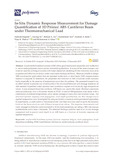JavaScript is disabled for your browser. Some features of this site may not work without it.
| dc.contributor.author | Baqasah, Hamzah | |
| dc.contributor.author | He, Feiyang | |
| dc.contributor.author | Zai, Behzad A. | |
| dc.contributor.author | Asif, Muhammad | |
| dc.contributor.author | Khan, Kamran Ahmed | |
| dc.contributor.author | Thakur, Vijay Kumar | |
| dc.contributor.author | Khan, Muhammad A. | |
| dc.date.accessioned | 2020-01-07T10:50:44Z | |
| dc.date.available | 2020-01-07T10:50:44Z | |
| dc.date.issued | 2019-12-12 | |
| dc.identifier.citation | Hamzah B, Feiyang H, Behzad AZ, et al., (2019) In-situ dynamic response measurement for damage quantification of 3D printed ABS cantilever beam under thermomechanical load. Polymers, Volume 11, Issue 12, December 2019, Article number 2079 | en_UK |
| dc.identifier.issn | 2073-4360 | |
| dc.identifier.uri | https://doi.org/https://doi.org/10.3390/polym11122079 | |
| dc.identifier.uri | https://dspace.lib.cranfield.ac.uk/handle/1826/14911 | |
| dc.description.abstract | Acrylonitrile butadiene styrene (ABS) offers good mechanical properties and is effective in use to make polymeric structures for industrial applications. It is one of the most common raw material used for printing structures with fused deposition modeling (FDM). However, most of its properties and behavior are known under quasi-static loading conditions. These are suitable to design ABS structures for applications that are operated under static or dead loads. Still, comprehensive research is required to determine the properties and behavior of ABS structures under dynamic loads, especially in the presence of temperature more than the ambient. The presented research was an effort mainly to provide any evidence about the structural behavior and damage resistance of ABS material if operated under dynamic load conditions coupled with relatively high-temperature values. A non-prismatic fixed-free cantilever ABS beam was used in this study. The beam specimens were manufactured with a 3D printer based on FDM. A total of 190 specimens were tested with a combination of different temperatures, initial seeded damage or crack, and crack location values. The structural dynamic response, crack propagation, crack depth quantification, and their changes due to applied temperature were investigated by using analytical, numerical, and experimental approaches. In experiments, a combination of the modal exciter and heat mats was used to apply the dynamic loads on the beam structure with different temperature values. The response measurement and crack propagation behavior were monitored with the instrumentation, including a 200× microscope, accelerometer, and a laser vibrometer. The obtained findings could be used as an in-situ damage assessment tool to predict crack depth in an ABS beam as a function of dynamic response and applied temperature. | en_UK |
| dc.language.iso | en | en_UK |
| dc.publisher | MDPI | en_UK |
| dc.rights | Attribution 4.0 International | * |
| dc.rights.uri | http://creativecommons.org/licenses/by/4.0/ | * |
| dc.subject | acrylonitrile butadiene styrene | en_UK |
| dc.subject | dynamic response | en_UK |
| dc.subject | fatigue | en_UK |
| dc.subject | crack propagation | en_UK |
| dc.subject | fused deposition modeling | en_UK |
| dc.subject | FDM | en_UK |
| dc.subject | Fused filament fabrication | en_UK |
| dc.subject | modal analysis | en_UK |
| dc.subject | cantilever beam | en_UK |
| dc.title | In-situ dynamic response measurement for damage quantification of 3D printed ABS cantilever beam under thermomechanical load | en_UK |
| dc.type | Article | en_UK |
| dc.identifier.cris | 25723622 |
Files in this item
The following license files are associated with this item:
This item appears in the following Collection(s)
-
Staff publications (SATM) [4365]

